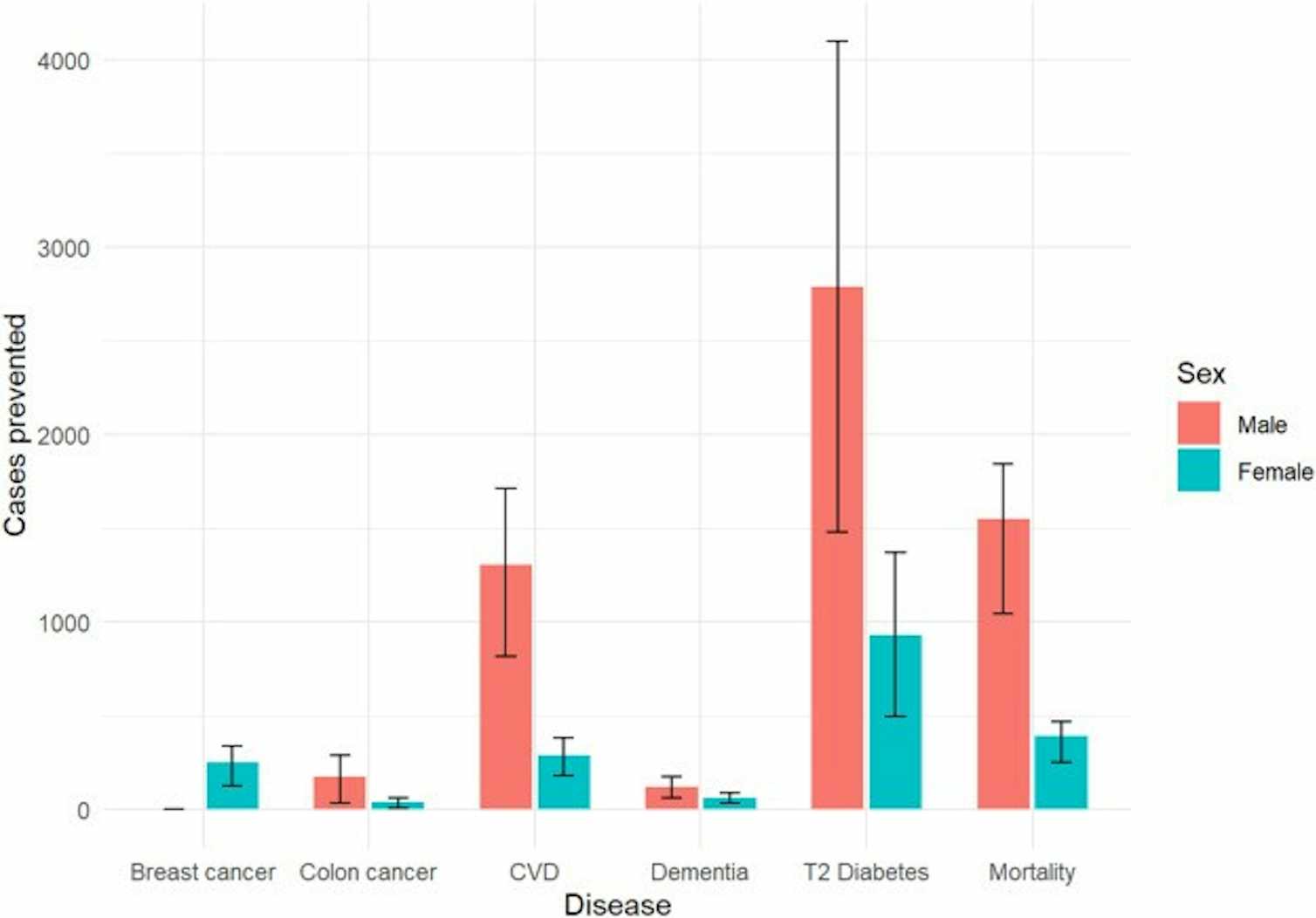By Kévin Jean, Conservatoire national des arts et métiers (CNAM); Audrey de Nazelle, Imperial College London; Marion Leroutier, Institute for Fiscal Studies, and Philippe Quirion, Centre national de la recherche scientifique (CNRS)
When the French government recently announced a plan to cut state spending by 10 billion euros, the budget for ecology, development and sustainable mobility was first on the chopping block, with cuts totalling 2.2 billion euros. At first glance, health appears to have been relatively spared, facing a cut of 70 million euros in its budget – a big number, but less than 1% of the total. Cutting state funding targeting sustainable mobility will, however, also contribute to deteriorating public health, in addition to increasing greenhouse gas emissions.
In a recent study, we evaluated the benefits for public health and the climate of cycling in France. Here’s what we learned.
The French don’t cycle very much
Our work consisted of analysing data from the decennial personal mobility survey, conducted by the National Institute of Statistics and Economic Studies (INSEE). It aims to describe people’s mobility practices and to assess how and why the French travel, on a daily basis as well as longer trips. The 2019 edition was based on a nationally representative sample of nearly 14,000 people interviewed in 2018 and 2019.

The first finding is that the French don’t cycle very much – just over 2km per week on average for those aged 18 and over. By comparison, Dutch people aged 75 and over cover an average of 13.7km per week, almost seven times more.
We also found that men are responsible for three quarters of the kilometres travelled by bicycle in France, whereas the practice is much more gender balanced in the Netherlands.
The health benefits of cycling in 2019
Second, we looked at the chronic diseases and deaths avoided by the levels of cycling in 2019. To do this, we used the quantitative health impact assessment method, which makes it possible to calculate the extent of the health consequences of exposure to a risk factor or, on the other hand, the health benefits of a protective factor within a given population.
In the case of cycling, the summary of epidemiological studies tell us that 100 minutes of cycling per week reduces all-cause mortality by 10% in adults. This relationship between cycling time and mortality risk can then be extrapolated and applied to observed levels of cycling.
In the same way, we selected five chronic diseases for which an association with physical activity had been reported in meta-analyses: cardiovascular diseases, type 2 diabetes, breast cancer, cancer of the prostate and dementia.
We were able to demonstrate that, while the levels of cycling observed in 2019 were modest, if they remained constant, they would make it possible to avoid nearly 2,000 deaths and 6,000 cases of chronic disease each year.

Significant costs avoided
These avoided deaths and chronic diseases also result in reduced health spending for the community. The direct medical costs that cycling helps avoid – hospitalisations, medical treatments, paid sickness leave – can be quantified using health insurance data: they amount to nearly 200 million euros each year.
If these direct medical costs have the advantage of being “tangible”, in the sense that they are monetary expenses, they represent only the tip of the iceberg: avoiding illness or death has a value for society, even in the absence of treatment or compensation. Indeed, illnesses and deaths have intangible consequences that affect not only the person concerned, but also those around them and the community. These include emotional damage, loss of well-being, impact on the lives of loved ones (especially caregivers), loss of productivity, and more.
To take this into account and consistently evaluate the costs of avoided diseases and deaths, health economists generally use the notion of “intangible health costs”, in other words, social health costs.
Based on this notion of intangible health costs, the commission – chaired by the economist Émile Quinet – recommended in 2013 to use the value of 3 million euros per death avoided (the equivalent of 3.48 million euros in current money) for the evaluation of public policies.

For our work, we thus estimated that cycling had made it possible to avoid 4.8 billion euros in social health costs in 2019. By taking the number of kilometres travelled by bike in the year of the survey (4.6 billion kilometres), we were able to estimate that each kilometre travelled by bike helps avoid around 1 Euro in social health costs.
What are the consequences of shifting short trips to cycling?
If our analysis provides information on the current health benefits of cycling, it can also tell us more about the benefits to be expected from policies to promote cycling. This is particularly relevant in the French context, since there is significant potential for the development of cycling. In fact, in France, more than half of journeys of less than 5 km are made by car.
Here, the detailed individual data from the personal mobility survey makes it possible to model a scenario in which a portion of journeys of less than 5 km made by car would be made by bicycle. In our study, we simulated the effects of a 25% shift from the car to the bicycle for such journeys. Our results indicate that while quite modest, this switch would make it possible to prevent 1,800 more deaths and avoid an additional 2.6 billion euros in social health costs.
To put this in context, road safety policies over the last 10 years would have prevented around 1,500 deaths per year.
Finally, this simulation allowed us to estimate that such a modal shift scenario would reduce CO2 emissions by 250 kilotonnes per year. This corresponds more or less to double the emissions avoided by the tax credits granted for energy-saving renovations of housing which were implemented in 2015 and 2016.
A potential that remains to be exploited
Despite long-standing scientifically documented benefits, it is distressing to note that cycling has not benefited from significant investments, at least over the decade 2010-2019.
As a result, between the 2008 and 2019 personal mobility surveys, the proportion of journeys made by bicycle has not increased: instead, it stagnated at around 3%. Local authorities often present investments in cycling infrastructure from a cost perspective, but our study reveals the extent of the benefits that can be expected in terms of health, as do numerous other studies on the advantages of cycling in an urban context.
It can therefore be a valuable ally in reducing air pollution and travel times. Promoting bicycle mobility is also a way of reducing the role of the automobile in the city, the harmful effects of which on health are often underestimated.
Furthermore, most energy-climate scenarios compatible with France’s climate commitments, whether developed by the French Environment and Energy Management Agency (ADEME) or the non-profit négaWatt, foresee a significant increase in the use of bicycles. In such a context, public authorities would have everything to gain from highlighting the convergence of the climate and health benefits of cycling.
We have shown in other studies that the implementation of the low-carbon transition scenario described in 2021 by négaWatt would make it possible to avoid around 10,000 deaths per year by 2050, which would translate to 40 billion euros in economic benefits. Conversely, achieving carbon neutrality by relying essentially on the electrification of the vehicle fleet would completely miss the health benefits of physical activity linked to active transport.
This would represent a tremendous missed opportunity to mobilise this possible synergy between climate change mitigation and improvement of public health.
This article was co-written by Émilie Schwarz, scientific project manager within the investigation unit of the “Processing and data analysis support” directorate of Santé publique France, the French national agency for public health.![]()
Kévin Jean, Maître de conférences en épidémiologie, Conservatoire national des arts et métiers (CNAM); Audrey de Nazelle, Senior lecturer, Imperial College London; Marion Leroutier, Postdoc Fellow, Institute for Fiscal Studies, and Philippe Quirion, Directeur de recherche, économie, Centre national de la recherche scientifique (CNRS)
This article is republished from The Conversation under a Creative Commons license. Read the original article.








